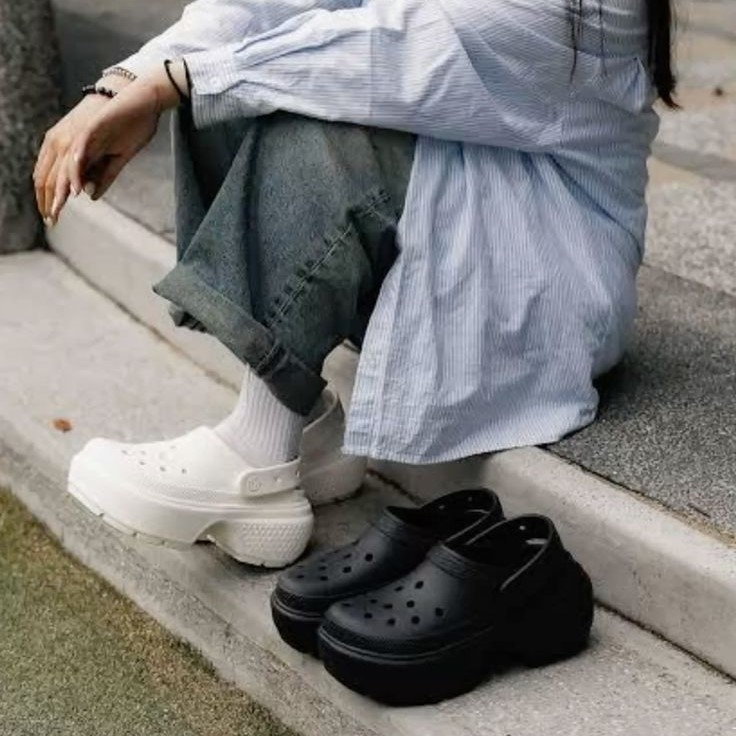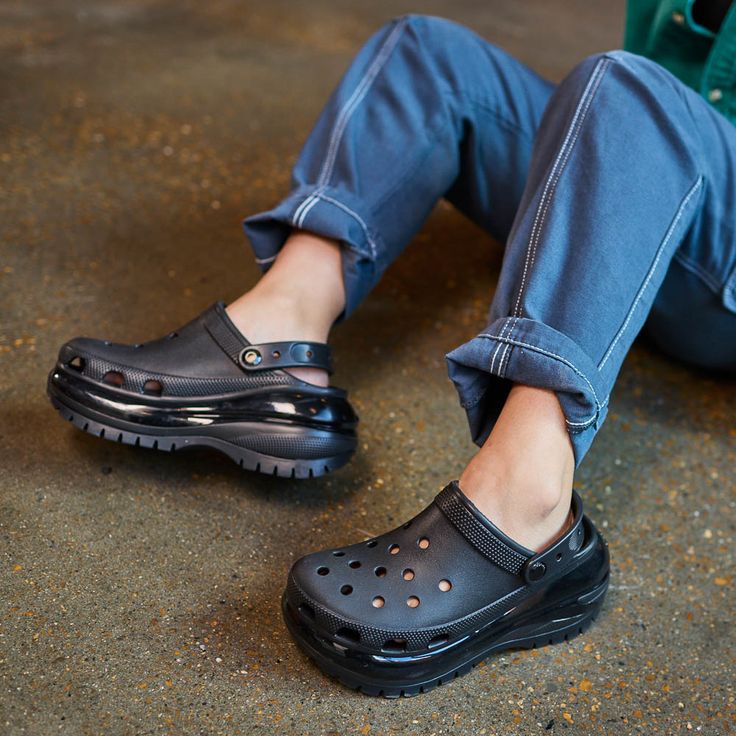What Does Non-Slip Mean in Footwear?
Non-slip footwear is designed to provide good grip on slippery surfaces. It helps prevent accidental slips and falls. Non-slip shoes typically feature innovative materials and tread patterns. These elements enhance traction, especially on wet or oily floors.
Key Features of Non-Slip Shoes
- Outsole Material: Most crocs non slip shoes use rubber or similar materials. These materials offer strong grip and durability.
- Tread Pattern: Effective non-slip shoes have unique tread designs. These patterns channel liquid away, reducing slipperiness.
- Shock Absorption: Many include cushioning for comfort during extended use. This feature also aids stability on shifting surfaces.
- Heel Support: Proper heel support secures the foot. It minimizes the risk of losing balance when walking or standing.
Benefits of Wearing Non-Slip Shoes for Work
- Improved Safety: Non-slip shoes protect you from falls in areas prone to spills. They’re crucial for settings like kitchens, hospitals, and outdoor jobs.
- Enhanced Comfort: Most designs reduce foot fatigue during long hours. Proper cushioning prevents aches and soreness.
- Boosted Productivity: Feeling secure and stable promotes focus and efficiency. Workers can complete tasks quicker without fears of slipping.
- Long-Term Health: Wearing non-slip shoes reduces strain on joints and muscles. This minimizes risks of injuries caused by repeated slips or poor posture.
Non-slip footwear isn’t just about avoiding accidents. It ensures comfort and supports your safety throughout the workday.
Are Crocs Certified as Non-Slip Shoes?
Crocs is a popular brand known for its comfortable and functional shoes. But are Crocs certified as non-slip? Yes, many Crocs are designed with slip-resistant features specifically for work environments. These shoes cater to various industries where safety and stability are crucial. Let’s explore the technology and testing behind Crocs’ slip-resistant certification.
Crocs Slip-Resistant Technology Explained
Crocs uses advanced slip-resistant technology to enhance safety. Their non-slip footwear features specialized tread patterns that improve traction. These tread designs channel liquids away from the sole, reducing the chances of slipping.
The material used in Crocs’ outsoles is another key feature. Crocs incorporate a high-quality rubber blend known as Crocs Lock. This material provides excellent grip on surfaces, whether dry, wet, or oily.
Additionally, these shoes often include durable construction and lightweight designs. This ensures they remain comfortable while resisting slips effectively. Many Crocs non-slip shoes meet or exceed industry standards, making them a trusted choice for workers.
How Crocs Test Their Non-Slip Properties
Crocs rigorously tests their slip-resistant shoes before releasing them to the market. The shoes undergo various assessments on wet, oily, and uneven surfaces. These tests simulate real-life working conditions to evaluate grip and traction.
The testing process often includes the Mark II machine test. This industry-standard test measures slip resistance on surfaces under controlled conditions. Crocs must meet high traction ratings to achieve certification.
Additionally, wear tests are conducted with actual users in various work environments. Feedback from these tests helps improve the shoes’ performance and durability.
Crocs’ commitment to testing ensures that their slip-resistant shoes perform reliably. This makes them a leading choice for professionals in healthcare, food service, and industrial settings.
Best Crocs Models for Non-Slip Work Environments
Crocs offers a variety of non-slip shoes for different industries. These models cater to specific needs like comfort, safety, and durability. Let’s explore the best Crocs options for healthcare, restaurant, kitchen, and industrial work settings.
Top Crocs Footwear for Healthcare Professionals
Healthcare workers need footwear that is comfortable and secure. Crocs provides excellent non-slip options for this sector.
- Crocs On-The-Clock Work Slip-On: This model features Crocs Lock tread for outstanding grip. Its contoured footbeds ensure comfort during long shifts. It’s perfect for nurses and hospital staff.
- Crocs Specialist II Clogs: These clogs offer extra arch support and thicker toe areas for added protection. The slip-resistant outsole keeps you steady on slippery hospital floors.
Recommended Crocs for Restaurant and Kitchen Work
Restaurant and kitchen staff often deal with wet and greasy surfaces. Crocs designs specific models to handle these conditions.
- Bistro Clogs: These clogs feature Crocs Lock slip-resistant tread. They’re easy to clean and highly durable, making them ideal for high-paced kitchen environments.
- Bistro Pro LiteRide? Clogs: Equipped with LiteRide? foam insoles, these shoes provide lasting comfort. The outsole delivers excellent traction on oily floors.
Crocs for Outdoor and Industrial Work Settings
Outdoor and industrial workers require non-slip shoes that can handle rugged terrains. Crocs offers reliable solutions tailored to these needs.
- All-Terrain Clogs: These clogs feature rugged outsoles for superior grip. They are lightweight yet highly durable, making them ideal for outdoor jobs.
- Crocs Work Hover Sneaker: This footwear provides a mix of style and function. It offers solid slip resistance and comfort for industrial work settings.
Each of these Crocs models caters to specific work environments, ensuring safety and comfort. When choosing, consider your industry’s needs and working conditions for the best performance.
How Do Crocs Perform on Different Surfaces?
Crocs are known for their slip-resistant technology, making them suitable for various surfaces. Let’s explore how they perform on wet and oily floors, outdoor terrain, and during prolonged wear.
Wet and Oily Floors
Crocs excel on wet and oily surfaces due to their advanced slip-resistant design. Their outsoles utilize Crocs Lock? tread patterns to provide superior grip. These patterns channel liquids away, reducing the chances of slipping. This makes them ideal for kitchens, hospitals, and restaurants where spills are common. Additionally, the rubber material enhances traction, even on slick surfaces. Workers feel confident navigating areas prone to grease and moisture.
Outdoor and Uneven Ground
Crocs offer reliable performance on outdoor and uneven terrains. Models like the All-Terrain Clogs feature rugged outsoles for stability. The durable construction handles rocky paths, muddy trails, and uneven ground with ease. These shoes are lightweight yet sturdy, making them perfect for outdoor work. Whether you’re in landscaping, agriculture, or industrial sectors, Crocs ensure safety and comfort.
Long Hours of Walking or Standing
Crocs are designed to support workers during extended periods of standing or walking. Their contoured footbeds and lightweight materials reduce foot fatigue. Features like shock absorption and arch support enhance comfort, even during long shifts. Non-slip properties prevent accidental falls, ensuring safety throughout the day. This makes Crocs a dependable option for professionals in healthcare, food service, and demanding industries.
Comparison: Crocs vs Other Non-Slip Shoe Brands
When choosing non-slip shoes for work, crocs non slip shoes often stands out for its unique features. However, comparing Crocs with other well-known non-slip shoe brands can provide clearer insights into their benefits and limitations.
Advantages of Crocs in Work Environments
- Lightweight and Comfortable: Crocs are designed to be exceptionally lightweight. This reduces foot fatigue during long shifts. Their ergonomic design, including contoured footbeds, ensures comfort for extended wear.
- Crocs Lock? Slip-Resistant Technology: The specialized tread patterns channel liquids away, improving traction on wet or oily floors. This slip-resistant technology performs effectively in food service, healthcare, and industrial settings.
- Ease of Cleaning: Crocs are made with materials that are easy to wipe or wash. This is particularly beneficial for restaurant workers dealing with spills or grease.
- Wide Range of Styles: Crocs offer versatile designs tailored for different professions. Healthcare workers, kitchen staff, and outdoor laborers can find options meeting their needs.
Limitations and Considerations Compared to Competitors
- Limited Support for High-Impact Jobs: While Crocs excel in slip-resistance, other brands like Skechers may offer better arch and ankle support for high-intensity work environments.
- Durability Concerns: Some users report quicker wear and tear compared to other established non-slip brands, such as Shoes For Crews or Dansko.
- Professional Style: Crocs’ casual appearance may not suit formal work environments. Competitor brands often provide sleeker designs that might feel more appropriate in settings like corporate kitchens or luxury hotels.
- Price vs. Features Balance: While reasonably priced, certain competitors may offer additional features, like anti-microbial lining or reinforced toes, at similar cost points.
Crocs remains a popular choice because of its comfort and slip-resistant features. However, depending on your specific workplace needs, exploring other brands like Skechers or Dansko might offer tailored solutions for demanding conditions.
Tips for Choosing the Right Non-Slip Shoes
Finding the best non-slip shoes is essential for safety at work. Consider several factors to make a smart choice. Evaluate the shoe’s design, material, and purpose before purchasing.
How to Evaluate Slip-Resistant Shoes
- Check Sole Material: Look for rubber or high-grade synthetic outsoles. These materials provide excellent grip.
- Examine Tread Patterns: Choose shoes with deep, unique tread designs. They help reduce slipperiness by channeling liquids away.
- Look for Certifications: Ensure the shoes meet industry standards for slip resistance. Certification guarantees reliability.
- Test for Comfort: Try wearing shoes for a few minutes. They should feel cushioned and supportive.
- Consider Durability: Check user reviews for wear and tear issues. Durable shoes save money over time.
- Match with Your Needs: Select a model suited for your workplace. For example, kitchens need better oily-surface traction.
Evaluating these factors ensures you pick shoes that perform well and last long.
Customizing and Maintaining Your Crocs for Work
Add Insoles
- Choose Orthopedic Insoles:
- Select high-quality orthopedic insoles specifically designed for arch support. Many brands cater to diverse foot types, ensuring you find a suitable option.
- Enhance Comfort:
- Using insoles can significantly improve comfort levels when wearing Crocs, especially during long hours of standing or walking. They provide additional cushioning that helps reduce foot fatigue.
- Consider Custom Options:
- If you have specific foot issues or require personalized support, consider consulting a podiatrist to obtain custom insoles. This might provide the best fit and comfort tailored to your needs.
- Compatibility with Crocs:
- Make sure that the insoles you opt for fit well inside your Crocs without causing crowdedness. A proper fit will ensure that your shoes remain comfortable and functional.
Proper Fit
- Ensure a Snug Fit:
- When choosing Crocs, always prioritize a snug fit. This means that the shoes should hold your feet securely without being too tight, allowing for movement without slipping.
- Check for Movement:
- Make sure that when walking, your heels do not lift out of the shoes excessively. If you feel any sliding or movement, consider trying a smaller size or a different style that offers a better fit.
- Safety Considerations:
- Loose-fitting shoes can lead to accidents, such as slipping or tripping. A secure fit not only enhances comfort but also helps ensure your safety while walking or standing.
- Assess Foot Shape:
- Remember that everyone’s foot shape is different. Pay attention to whether your Crocs are suited for wider or narrower feet, as this can affect how snugly they fit.
Regular Cleaning
- Frequency of Cleaning:
- Establish a regular cleaning routine for your Crocs. Depending on usage, this could mean cleaning them every few days or weekly.
- Use Mild Soap:
- Choose a mild soap mixed with water for cleaning, as harsher chemicals can deteriorate the material. A gentle scrub with a soft brush or cloth can effectively remove dirt and stains.
- Retain Functionality:
- Regular cleaning helps maintain the functional aspects of your Crocs, such as the tread pattern. Keeping them clean enhances your overall experience and comfort while wearing them.
- Drying:
- After cleaning, allow your Crocs to air dry in a shaded area to prevent warping. Avoid direct sunlight, which can degrade the material over time.
Inspect Treads
- Check Monthly:
- Make it a habit to inspect the treads of your Crocs at least once a month. A quick visual check can help you assess wear and determine if they’re still safe to wear.
- Signs of Wear:
- Look for signs of excessive wear, such as smooth patches or cracks in the outsole. These indicators suggest it might be time to replace your Crocs to maintain grip and stability.
- Safety First:
- Worn-out treads can lead to slips and falls, especially on slippery surfaces. Prioritize your safety by regularly checking and replacing shoes with compromised treads.
- Document Lifespan:
- Keeping track of how long you’ve had your Crocs can also help you determine when it’s time for an inspection. Shoes used frequently may require more regular checks.
Rotate Footwear
- Utilize Multiple Pairs:
- If you wear Crocs for long shifts or extensively, consider rotating between multiple pairs. This practice reduces the wear and tear on any single pair, extending their overall lifespan.
- Prevent Overuse:
- Overusing one pair can lead to quicker degradation. By rotating shoes, each pair can recover and maintain its shape and cushioning, enhancing comfort and performance.
- Adapt to Different Environments:
- Different Crocs styles may be better suited for various environments. Rotating styles can provide the best fit and style for specific activities or settings.
- Comfort Variation:
- Switching between different pairs of Crocs can also give your feet a break from the same pressure points, reducing fatigue and discomfort during extended wear.
By customizing and maintaining your crocs non slip shoes, you ensure better performance and longevity. Pair these practices with proper evaluation to maximize safety and comfort at work.
Frequently Asked Questions About Crocs and Slip Resistance
Are All Crocs Slip-Resistant?
Not all Crocs are slip-resistant. Some models lack the Crocs Lock? tread technology. Always check the product description for slip-resistant features. Many Crocs for work purposes specifically highlight non-slip properties. These include healthcare, kitchen, and industrial-focused models. If unsure, opt for certified non-slip options.
Can You Use Crocs in Professional Settings?
Yes, many Crocs are designed for professional use. Models like Bistro Clogs are tailored for kitchens and hospitals. They meet safety standards and provide excellent slip resistance. Lightweight materials also make them comfortable for long shifts. However, their casual appearance may not fit formal workplaces. Assess your workplace’s dress code before wearing them.
Do Crocs Lose Their Slip-Resistant Properties Over Time?
Yes, the crocs non slip shoes can wear out with prolonged use. Consistent use on harsh surfaces accelerates tread wear. Regularly check the outsoles for signs of deterioration. Replace them when the tread looks smooth or worn-out. Proper maintenance can help extend their slip-resistant performance.




